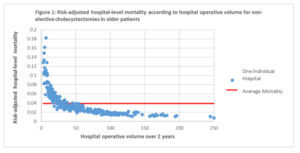The Need for Accredited Surgery Centers to Perform Non-Elective Cholecystectomy in Elderly Patients
Author(s):
Robert Becher; Michael DeWane; Nitin Sukumar; Marilyn Stolar; Kimberly Davis; Felix Lui; Adrian Maung; Thomas Gill; Kevin Schuster
Background:
The American College of Surgeons’ accreditation process for surgical centers verifies specific criteria to ensure standards and optimize outcomes. We investigated the relationship between hospital volume for non-elective cholecystectomy and mortality rate in an elderly population to assess the need for verified centers for older patients with surgical emergencies.
Hypothesis:
We hypothesized that increased hospital volume for non-elective cholecystectomy in the elderly would lead to decreased post-operative in-hospital mortality for older patients.
Methods:
Patients ≥65 years who underwent urgent laparoscopic or open cholecystectomy for cholecystitis were identified in the California State Inpatient Database for the years 2010-2011. Beta regression models for proportions as outcomes examined the relationship between 2-year operative volume and in-hospital risk-adjusted mortality at the hospital-level.
Results:
A total of 17,429 older patients underwent cholecystectomy at 298 hospitals. The average risk-adjusted morality rate was 3.9%. For every increase in hospital cholecystectomy volume in the elderly, mortality consistently decreased (p<0.001; figure 1), from >10% at the lowest-volume hospitals to <1.5% at the highest-volume centers. If an institution performed ≥28 cholecystectomies over the 2 years, there was a 95% chance that that institution performed at or above the average risk-adjusted mortality rate; 209 hospitals (70%) achieved this benchmark. Over the study period, for every 100 non-elective cholecystectomies performed at hospitals doing ˂28 cases, 3 elderly lives may have been saved if the operation had been done at a ≥28-case hospital.

Conclusions:
Older patients undergoing non-elective cholecystectomy for cholecystitis might reduce their risk of mortality by having the operation performed at a higher-volume hospital. These results support the concept of verification for accredited surgery centers that provide emergency care to elderly patients.

